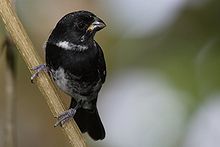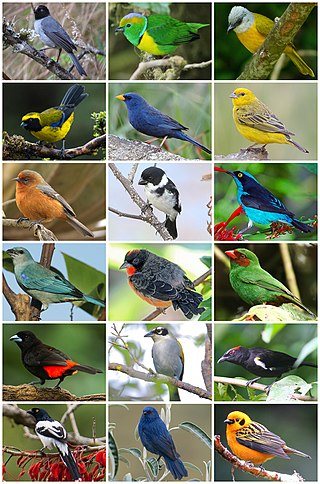| Image | Common name | Scientific name | Distribution |
|---|
 | Lesson's seedeater | Sporophila bouvronides | Bolivia, Brazil, Colombia, Ecuador, French Guiana, Guyana, Panama, Peru, Suriname, Trinidad and Tobago, and Venezuela. |
 | Lined seedeater | Sporophila lineola | Argentina, Bolivia, Brazil, Colombia, Ecuador, French Guiana, Guyana, Panama, Paraguay, Peru, Suriname, and Venezuela. |
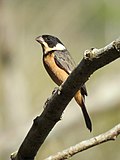 | Cinnamon-rumped seedeater | Sporophila torqueola | western Mexico |
 | Morelet’s seedeater | Sporophila morelleti | Rio Grande Valley through eastern Mexico and Central America to western Panama |
 | Variable seedeater | Sporophila corvina | southern Mexico through Central America to the Chocó of northwestern South America |
 | Grey seedeater | Sporophila intermedia | Brazil, Colombia, Ecuador, Guyana, Trinidad and Tobago, and Venezuela. |
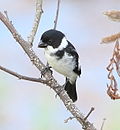 | Wing-barred seedeater | Sporophila americana | north-eastern Venezuela, Tobago, the Guianas, Brazil |
| White-naped seedeater | Sporophila fringilloides | Brazil, Colombia, and Venezuela. |
 | Black-and-white seedeater | Sporophila luctuosa | Bolivia, Brazil, Colombia, Ecuador, Peru, and Venezuela. |
 | Double-collared seedeater | Sporophila caerulescens | Argentina, Bolivia, Brazil, Paraguay, Peru, and Uruguay |
 | Yellow-bellied seedeater | Sporophila nigricollis | Costa Rica to Bolivia |
 | Dubois's seedeater | Sporophila ardesiaca | east-central Brazil |
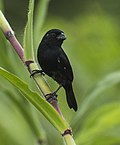 | Thick-billed seed finch | Sporophila funerea | southern Mexico, through Central America, to the Chocó in Colombia and Ecuador. |
 | Chestnut-bellied seed finch | Sporophila angolensis | Trinidad, Tobago, east Colombia, Venezuela, the Guianas, Bolivia to east Brazil, Paraguay and northeast Argentina |
 | Nicaraguan seed finch | Sporophila nuttingi | Costa Rica, Nicaragua and northwestern Panama. |
 | Great-billed seed finch | Sporophila maximiliani | Brazil |
 | Large-billed seed finch | Sporophila crassirostris | Brazil, Colombia, Ecuador, French Guiana, Guyana, Peru, Suriname, Trinidad and Tobago, and Venezuela. |
 | Black-billed seed finch | Sporophila atrirostris | Ecuador, Peru and northwestern Bolivia |
 | Slate-coloured seedeater | Sporophila schistacea | Central America, the southwestern Amazon Basin, Colombia, Venezuela, Trinidad and Tobago and the Guianas. |
 | Temminck's seedeater | Sporophila falcirostris | Argentina and southeastern Brazil |
 | Buffy-fronted seedeater | Sporophila frontalis | northeastern Argentina and along the southeastern Brazil |
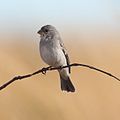 | Plumbeous seedeater | Sporophila plumbea | Argentina, Bolivia, Brazil, Colombia, French Guiana, Guyana, Paraguay, Peru, Suriname, and Venezuela. |
 | Tropeiro seedeater | Sporophila beltoni | Brazil |
 | Rusty-collared seedeater | Sporophila collaris | Argentina, Bolivia, Brazil, Paraguay, and Uruguay. |
 | White-throated seedeater | Sporophila albogularis | Brazil. |
 | White-bellied seedeater | Sporophila leucoptera | Bolivia, Paraguay and eastern Brazil |
 | Parrot-billed seedeater | Sporophila peruviana | Ecuador and western Peru. |
 | Chestnut-throated seedeater | Sporophila telasco | southwestern Colombia to far northern Chile. |
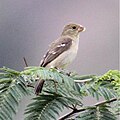 | Drab seedeater | Sporophila simplex | Ecuador and Peru. |
 | Chestnut-bellied seedeater | Sporophila castaneiventris | Bolivia, Brazil, Colombia, Ecuador, French Guiana, Guyana, Peru, Suriname, and Venezuela |
 | Ruddy-breasted seedeater | Sporophila minuta | Brazil, Colombia, Costa Rica, Ecuador, El Salvador, French Guiana, Guatemala, Guyana, Honduras, Mexico, Nicaragua, Panama, Suriname, Trinidad and Tobago, and Venezuela. |
 | Copper seedeater | Sporophila bouvreuil | Brazil and Suriname. |
 | Black-and-tawny seedeater | Sporophila nigrorufa | eastern Bolivia and southwestern Brazil. |
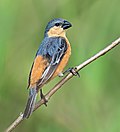 | Tawny-bellied seedeater | Sporophila hypoxantha | Argentina, Bolivia, Brazil, Paraguay, and Uruguay. |
 | Dark-throated seedeater | Sporophila ruficollis | Argentina, Bolivia, Brazil, Paraguay, and Uruguay |
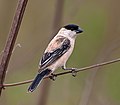 | Pearly-bellied seedeater | Sporophila pileata | Brazil, Paraguay, northern Uruguay and northeastern Argentina. |
 | Rufous-rumped seedeater | Sporophila hypochroma | Bolivia, Brazil, Paraguay, Argentina, and Uruguay |
 | Chestnut seedeater | Sporophila cinnamomea | Argentina, Brazil, Paraguay, and Uruguay |
 | Marsh seedeater | Sporophila palustris | Argentina, Brazil, Paraguay, and Uruguay. |
 | Black-bellied seedeater | Sporophila melanogaster | Brazil. |
 | Ibera seedeater | Sporophila iberaensis | Argentina. |
|
